Baulking away from the Census, Household spending and PISA surveys – is something amiss?
RN Bhaskar
The metaphor that could best describe India is an empty classroom in a not too swanky school. This is the image which comes to mind when one finds India missing from the list of 81 countries that participated in the latest PISA tests to find their ranking for mathematics, reading and science. The results were announced by the OECD on 5 December 2023 (https://www.oecd.org/publication/pisa-2022-results/).
The last time India participated in the PISA tests was in 2009. The then government was stung when it saw the scores. India stood second from the bottom, securing a rank of 72 among 73 participating countries. It withdrew from subsequent PISA tests. Then in 2019, possibly because of growing pressure on the country’s leaders who liked to call themselves Vishwagurus (teachers of the world), India decided to participate in the 2021/2022 PISA tests (https://theprint.in/india/education/india-prepares-hard-for-pisa-global-student-assessment-test-last-time-it-finished-in-bottom-2/316843/).
But in February 2022, just a few weeks before the PISA tests were to be scheduled, India backed off (https://www.telegraphindia.com/india/central-government-cries-off-global-test-forteenagers/cid/1875585). The government claimed that it was on account of the impact of Covid-19. But that explanation sounds weak to the point of being laughable. This is obvious from the way 81 other countries opted to participate, despite the pandemic which afflicted the entire world not just India. China, one of the most savagely affected, also participated.
As the first volume of “PISA 2022 results – the state of learning and equity in education” published by the OECD — puts it, “Up to the end of the 1990s, the OECD’s comparisons of education outcomes were mainly based on measures of years of schooling, which don’t necessarily reflect what people actually know and can do. The Programme for International Student Assessment (PISA) changed this. The idea behind PISA lay in testing the knowledge and skills of students directly, through a metric that was internationally agreed upon; linking that with data from students, teachers, schools, and systems to understand performance differences; and then harnessing the power of collaboration to act on the data, both by creating shared points of reference and by leveraging peer pressure.”
It goes on to add that PISA “owes its success to a collaborative effort between the participating countries, the national and international experts and institutions working within the framework of the PISA Consortium, and the OECD. Subject matter experts, practitioners and policy makers from the participating countries worked tirelessly to build agreement on which learning outcomes are important to measure and how to measure them best; to design and validate assessment tasks that can reflect those measures adequately and accurately across countries and cultures; and to find ways to compare the results meaningfully and reliably. The OECD co-ordinated this effort and worked with countries to make sense of the results and compile the reports.”
To ensure that students and countries are not evaluated on just one subject, the tests consider three different skills – mathematics, reading and science. Other subjects like history and geography, which can have huge subjective elements, are not touched.
The results show that Singapore fared the best in respect of all the three skills. Obviously, India is not there, because it chose not to participate.
But this tendency to shy away from any kind of exercise which confirms the poor state of affairs in India is nothing new. It has done this with PISA all the time since 2009.
What is worrying is that the country has chosen to do the same with any other survey that may show up a not so sanguine state of affairs.
Instead, many spokespersons for the government have resorted to bluster. They have even attempted to try to take the country back to the dark ages.
Take a sampling of two videos by Akash Banerjee on how science is sometimes promoted in India by government funded bodies — https://www.youtube.com/watch?v=mHwL1VKZ3x4 – or on how an Astrologer Chooses Team India; and https://www.youtube.com/watch?v=ipU5mEPd8Kg. Both videos bemoan the way Superstition & Blind Faith Is Killing Science.
It may be mentioned here that even as recently as 30 November 2023, the University Grants Commission (UGC) sent out letters to educational institutions asking them to celebrate the birth centenary of an RSS leader (https://timesofindia.indiatimes.com/city/mumbai/ugc-letter-to-mark-rss-netas-birth-yr-sparks-row/articleshow/105607090.cms). Nothing wrong with celebrating the birth anniversary of any leader. But should the UGC be playing the role of an event manager? Isn’t this one way in which academic standards get weakened?
While the videos referred to above may be dismissed as being merely hilarious, the situation assumes serious overtones when one looks at India’s gross enrolment ratio (GER) scores.
First look at where India stands in the world’s pecking order.
No, the Vishwaguru is not there among the top ten. Instead, it ranked #26 with a GER of 28.6 in 2019. But things appear to have gone worse since then.
In a reply before the Lok Sabha in February this year (https://www.education.gov.in/lok-sabha-uq-no-655), the government mentions that its all-India GER stood at 27.3. What this means is the India’s GER fell from 28.6 in 2019 to 27.3 in 2023.
 That could explain why India does not want to participate in any international survey which evaluates the competitiveness of Indian students against students in the world. If the results of 2009 are any indication, the results could be crushing.
That could explain why India does not want to participate in any international survey which evaluates the competitiveness of Indian students against students in the world. If the results of 2009 are any indication, the results could be crushing.
Unfortunately, without education, healthcare and a vibrant job market, all talk of being a great nation falls flat.
And in spite of this, as recently as in October 2023, India’s leaders continue to talk about how the world is turning to India for leadership and guidance (https://www.indiatoday.in/india/story/mohan-bhagwat-on-g20-india-presidency-dharma-gandhi-culture-kolkata-2444049-2023-10-03).
Evasion elsewhere as well
Such forms of refusal to confront the truth can be found elsewhere as well.
- Data on poverty surveys, conducted by the NSSO, was last placed before the Parliament only for 2011-12 (https://www.thehindu.com/news/national/opposition-questions-delay-in-survey-to-assesspoverty/article66695567.ece). This issue was raised by opposition party members before the Rajya Sabha in April 2023.
- Data on unemployment was cancelled by the government—ostensibly because the findings were flawed. Two non-governmental members of the National Statistical Commission (NSC) resigned in January 2019. They were reportedly disappointed over the way the government had sidelined them. Though, as per the NSC website, their tenure was supposed to end in 2020, they resigned from their posts much earlier. The government’s failure to recognise the commission’s contribution and delay in the release of new NSSO (National Sample Survey Office) data were the final triggers (https://www.businesstoday.in/latest/economy-politics/story/2-non-govt-national-statistical-commission-members-resign-over-delay-in-release-of-nsso-data-162904-2019-01-29).
- Results of the National Statistical Office’s consumption expenditure survey 2022-23, likely to be available by December this year, may now be released only after the general elections in 2024 (https://indianexpress.com/article/opinion/editorials/express-view-on-delay-of-consumptionexpenditure-surveys-census-let-data-flow-8567767/).
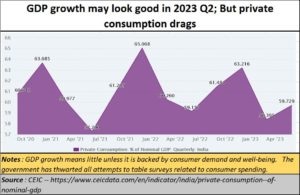 Similarly, earlier consumption expenditure surveys have been pushed aside. There has been no such survey since 2017-18 when the consumption expenditure survey was junked by the government due to “quality issues”, The state of consumption assumes significance because despite a surge in GDP in the second quarter of 2023, consumption has been under strain. According to the Hindu (https://www.thehindu.com/opinion/editorial/data-interrupted-on-official-household-spendingsurvey/article65354109.ece) “the result may be known towards the latter half of 2024, provided the Government permits the release.” According to the Economic Times, “GDP base revision to [be] hit as Household Consumer Expenditure Survey gets delayed (https://economictimes.indiatimes.com/news/economy/indicators/gdp-base-revision-to-take-hit-as-household-consumer-expenditure-survey-gets-delayed/articleshow/76422943.cms). In its report of December 1, 2023, DBS bank also stated that private consumption growth may slow (https://www.cnbc.com/2023/12/01/-india-economy-in-a-sweet-spot-but-private-consumptionmay-slow-dbs.html). Such views have been echoed by Rajani Sinha, chief economist, CARE Ratings (https://www.business-standard.com/economy/news/q2-gdp-investment-growth-at-5-qtr-highhousehold-consumption-slows-down-123113001143_1.html).
Similarly, earlier consumption expenditure surveys have been pushed aside. There has been no such survey since 2017-18 when the consumption expenditure survey was junked by the government due to “quality issues”, The state of consumption assumes significance because despite a surge in GDP in the second quarter of 2023, consumption has been under strain. According to the Hindu (https://www.thehindu.com/opinion/editorial/data-interrupted-on-official-household-spendingsurvey/article65354109.ece) “the result may be known towards the latter half of 2024, provided the Government permits the release.” According to the Economic Times, “GDP base revision to [be] hit as Household Consumer Expenditure Survey gets delayed (https://economictimes.indiatimes.com/news/economy/indicators/gdp-base-revision-to-take-hit-as-household-consumer-expenditure-survey-gets-delayed/articleshow/76422943.cms). In its report of December 1, 2023, DBS bank also stated that private consumption growth may slow (https://www.cnbc.com/2023/12/01/-india-economy-in-a-sweet-spot-but-private-consumptionmay-slow-dbs.html). Such views have been echoed by Rajani Sinha, chief economist, CARE Ratings (https://www.business-standard.com/economy/news/q2-gdp-investment-growth-at-5-qtr-highhousehold-consumption-slows-down-123113001143_1.html).
- Census 2021 has been deferred indefinitely. The last census was placed before the parliament in 2011. Effectively, the country’s planners and economists have been working on data that is over 13 years old. In addition to this being headlined by leading media in India, it has also been highlighted by some of the world’s most reputed organisations like the Lancet (https://www.thelancet.com/pdfs/journals/lancet/PIIS0140-6736(23)01477-0.pdf).
Rudderless India
Without the right data, the country remains rudderless. The only two things that are likely to continue growing (for the next couple of years at least) – and will be tomtommed each time — are GDP and GST (Goods and Service Tax). The latter will keep growing because all government largesse will eventually translate into GST. As for the former, when you have a population of 1.4 billion, even a Rs.10 collected from each individual each year, will add Rs.14 billion to the exchequer. It is an idiot proof way to grow GDP. Moreover, you can boost GDP through borrowings as well. Watch India’s surge in borrowings, current account deficit and the slowdown in foreign direct investments (Free subscription — https://bhaskarr.substack.com/p/why-have-personal-loans-become-sticky?sd=pf). And do pay heed to India’s unemployment.
You need data to resolve these, and proper planning. Mere chest thumping and crowing about India’s GDP will not do.
But many politicians are unconcerned. As one newspaper put it “In his speech after the BJP swept to power in Madhya Pradesh, Rajasthan and Chhattisgarh, Prime Minister Narendra Modi called it a victory of the poor, the deprived and the tribals, among others. The acknowledgment is with a reason — aspirational districts, some of the most backward in the country, and constituencies reserved for tribals have fuelled the BJP’s win in the three states whose results were declared on Sunday. https://indianexpress.com/article/political-pulse/aspirational-districts-among-indias-poorest-boost-bjps-madhya-pradesh-chhattisgarh-rajasthan-poll-victory-9054587/).
India needs to pay more respect to data sharing, and to wealth generation. India needs employment and investments. Little has been done lately to encourage them.





























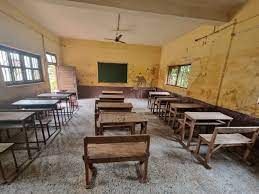
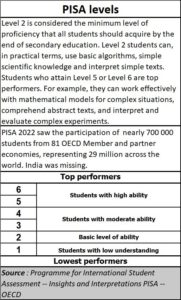
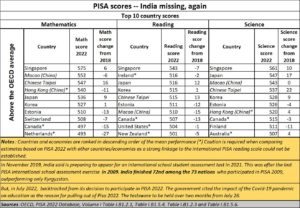
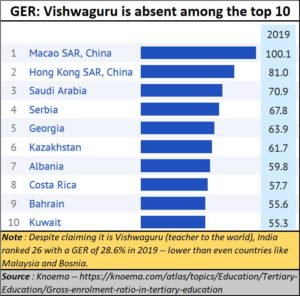







COMMENTS